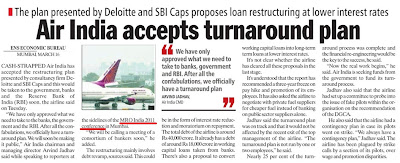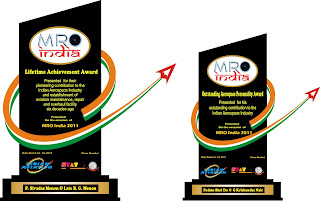Key Indian Aerospace firms join forces to provide further impetus to the country’s growing Aerospace MRO sector
 |
| From Left: Ravi Menon, Executive Director, AirWorks; Bharat Malkani, Managing Director, Max Aerospace; B.P. Baliga, former Vice President, Jet Airways / former Director, Engineering, Air India; Pulak Sen, Editor-in-Chief of Indian Aviation |
Mumbai, 23rd June, 2011: Several of the country’s key Aerospace Maintenance Repair and Overhaul (MRO) firms such as AirWorks India, Max Aerospace, Horizon Aircraft Maintenance, United Helicharters, Reliance Airports and Kingfisher Airlines, as well as The Rotor Wing Society of India have begun the process of forming the - MRO Association of India - with the intention of assisting and guiding the evolution of the Indian aerospace market towards becoming a prime MRO destination for both domestic and international airline carriers and helicopter charter service providers. The aim behind the association will be to function as a “Working Group” that will facilitate and support the government in streamlining the overall industry framework in order to provide an added boost in developing the sector. With a stronger focus, both the national and state governments would benefit significantly, which would translate into higher revenue for the Indian economy and thereby enhance Gross Domestic Product (GDP) growth.
Elaborating on the formation of the association, Mr. Ravi Menon, Executive Director, AirWorks said, “At present, due to the current national and state regulations pertaining to aircraft maintenance and service, it is more viable for our Indian airline carriers and helicopter charter service providers to fly their concerned aircrafts to MRO destinations that are based either in other parts of Asia, the Middle East or as far away as Europe. However, this results in a huge operational delay and fuel loss, as aircrafts flown for servicing, are times not able to carry any passenger loads. The total outgoing expenditure by the Indian civil aerospace market each year amounts to $700 million. That is a loss of revenue not only for the airline market but to the government as well. Therefore, what we aim to carry out with the association is to map out a clear growth path that would showcase how this revenue need not be lost to foreign competitors and in turn how India can transform itself into an attractive MRO destination”
Adding to this, Mr. Bharat Malkani, Managing Director, Max Aerospace, said “Our aim for the association was to have likeminded members, who shared the same views and concerns as us and who wanted more to be done as far as Aerospace MRO work goes in India. We do intend to welcome other firms related to the MRO sector, as well several associations and prominent figures, who may provide us with their expert views and guidance in order to facilitate our overall goal.”
The first meeting of the MRO Association of India was convened by Mr. Pulak Sen, Editor-in-Chief of Indian Aviation, who being one of its pioneering members, had felt the urgency of addressing the slow growth of the MRO sector. In his opening remark, Mr. Sen said “The formation of such a body is paramount in order to provide MRO organizations, who strongly feel the need for change to occur, a platform to voice their concerns with the aerospace authorities in the country. As we have seen, the desire for such change was articulated by both domestic and foreign aerospace companies at the recently held MRO India 2011, which was India’s first ever MRO exhibition and conference held in Mumbai. Therefore, we must now endeavor to formulate the appropriate course of action in order to highlight the hurdles that currently exist, the feasibility of proposed corrective measures for the sector and the benefit that both the authorities and the Indian aerospace market may avail of.”
The next meeting of MRO Association of India is slated to be held in Mumbai on July 5th, 2011.
Over the past 16 years, India has seen more engineering and R&D investments in aerospace than the U.S. or Europe. A recent report by the Aeronautical Society of India estimates the MRO market to grow from below U.S. $1 billion to about U.S. $ 2.6 billion by the year 2020. It is also estimated that the major segments of the MRO business, in terms of value, will be engines (30-35%), airframe (20-25%), components (20-25%), and line maintenance (20-25%). Therefore, the opportunity for market players to establish MRO facilities within the country is highly lucrative. In addition, established MRO facilities within the country may ensure greater savings for aerospace clients and in turn assist in further safeguarding the local and global environment.














